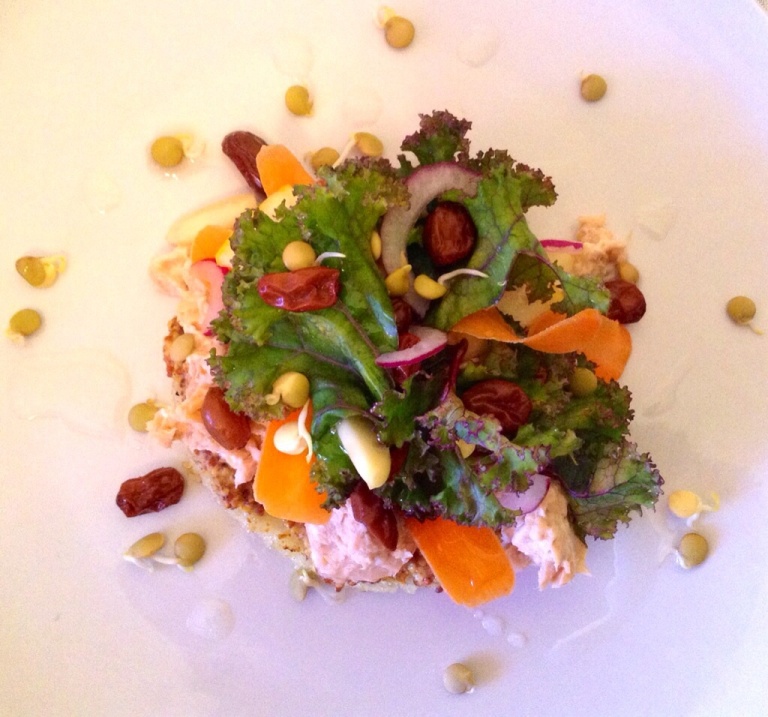Still preparing for Turkey Day sans turkey. I think I am favoring this dish for Christmas instead, though: Delicata Squash and Fall Fruits in a Dessert Wine Sauce.


Delicata squash from my local food Co-op inspired this dessert. I have never used it in a sweet preparation before. What started me on the path was having purchased thick and regular rolled oats. I began thinking about a fruit crumble, afterwards thinking about a savory crumble with the squash. Then, I thought about a sweet crumble with the squash. Ultimately, I didn’t use the oatmeal at all and went for this easy stove-top dessert. Many times, dessert wins out in my life!
I must say, this was one of my favorite dessert experiments. I might change the presentation somewhat (a little more refined, perhaps?), but the flavors came together beautifully.
The Prep: I sprinkled a little salt and brown sugar (coconut palm sugar) on the squash and seared them on both sides. Diced apples were also caramelized with a little brown sugar. I made a sauce from water, brown sugar, raw sugar & stevia, homemade dessert wine (as it’s on the sweeter side), lemon zest, lemon juice, cinnamon, nutmeg, and vanilla. I generally just use whatever sweeteners I have at the time for my dishes (like agave, raw sugar, etc.). For some preps, though, I choose to either purposefully use or avoid sweeteners with flavors that are more pronounced (maple, honey, or molasses, etc.). I thought about maple for this prep, but I decided to go with the more subtle brown palm sugar. I used my homemade wine, as it was handy…but, I can think of several wine shop purchases that would be suitable. So, I will change the title to reflect the appropriate wine when I’ve tested it out.
The Stew: I added the squash, apples, dried figs, and raisins to the sauce and let them stew. The squash and fruit were plated, and I drizzled a little bit more of the reduced sauce over the top. As I’ve previously written, I am fasting from butter right now…otherwise, I would have finished with a little at the end. If I wanted to make it more fancy, I would have spiked it and flambéed. Remember I said I love food and drinks on fire!
The Finish: A sprinkling of roasted nuts and pom seeds and a whip of homemade non-fat yogurt with raw coconut butter, vanilla, and raw sugar & stevia.
——————
Also, just a quick update on veg tamales. Last ‘My Way’ post, I linked to a recipe for vegan tamales, so check it out. I made a couple of batches testing the steam and slow cooker methods from the link. I just switched up my fillings and added a little cumin to the dough (vs. faux beef broth). I probably used less than a quarter of the oil the recipe called for (just regular veg oil), and they turned out fab (in my opinion). Less calories means we can eat more, right 😉 . I was also inspired by another recipe using a black bean chili filling. I used a veggie curry filling for one batch:

and, I used a “breakfast burrito” filling for the other (I told you I was stuck on breakfast burritos 😉 ):

The Veggie Curry: Delicata Squash, Tomato, and Black Bean. Sauce was made from sautéed onion, garlic, and chile, my own curry blend, cinnamon, brown sugar (palm sugar), and apple cider vin. I used the same sauce to top it off with, but added a bit of tomato paste & made it a little sweeter than normal (because I love sweet, as you know).
The “Breakfast Burrito”: Scrambled Eggs, Tomatoes, Mushrooms, Black Beans, Green Bells, and Asparagus. I’m also fasting from cheese, otherwise cheese most assuredly would have been included. Eggs were initially cooked very soft, as to not overcook while the tamale was steaming. Topped with my lacto-fermented salsa.
So many different ingredients and dough combos you can use for tamales. I would like to try some Asian flavors next. I used corn husks to wrap most of the tamales, but decided to test out another method, too. I figured some people reading may not have easy access to corn husks. They are readily available here in the Southwest, but I’m not so sure about other places in the country (or world). I thought making tamales is similar to making sushi, so I used parchment paper and a sushi roll mat to roll a few. I just secured the parchment with a little tape (yes, tape! Like a wrapped package or present). You will not get the texture that the corn husks give the dough, but they cooked up fine. They are also very easy to remove from the paper. If you use the slow cooker method, though, you may want to find a way to put a little water into the pot. The corn husks are soaked in water, so that is enough to provide the steam. Perhaps some slow cookers come with steamer racks like larger electrical roasters? Anyway, I think this is a good makeshift method, and you can probably come up with even more ways. The sushi roll mat may not be absolutely necessary, but it made the rolling very easy. Tamales freeze very well, so it’s nice to make a big batch for when the mood strikes.








You must be logged in to post a comment.